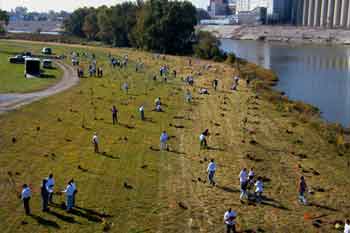ARBOR is an acronym for Answers for Restoring the Bank Of the River. The project is the result of a request from the indianapolis Department of Parks and Recreation (IndyParks), Office of Land Stewardship, for better data on how to reforest the many degraded floodplains in the City.
Lilly ARBOR

Project overview
The project area is an eight-acre strip of floodplain between 10th Street and New York Street along the White River in downtown Indianapolis. Prior to the project, this area was dominated by mowed turf grass and a few pioneer species. CEES service learning projects removed over 700 bags of trash and debris from the floodplain prior to it being replanted with native vegation as part of a comparitive, experimental floodplain reforestation program.
The project started with the planting of almost 1400 native trees. The 1-mile stretch of riverbank is evolving into a complex floodplain forest as the trees grow and other species gradually recolonize the area. The massive experiment will test the best way to restore riverbanks by comparing the three most common methods for planting trees to restore native forests. A 10+ years of monitoring and assessment have provided - and will continue to provide valuable data on reforestation strategies.
Project history
In 2000, CEES led students, and Lilly volunteers in the planting of almost 1400 trees, in what is now known as the Lilly ARBOR, in collaboration with the Indianapolis Parks, Department Office of Stewardship and the U.S. Fish and Wildlife Service as well as many other local, state and federal agencies (White River Riparian Restoration Project, Executive Summary, 2000).

Among the goals of the White River Riparian Restoration Project were to “strengthen experiential environmental education in the curriculum at IUPUI by providing students opportunities to engage in service and research related to riparian (river margin) restoration along White River” and to “help complete the last key component of a conservation corridor through Marion County” (Embracing and Enhancing IUPUI’s Natural Heritage: a Concept Plan, 1999). As the trees and shrubs have grown during the last 12 years, IUPUI students have gathered annual tree data, as well as conducted occasional studies of Lilly ARBOR birds.
Project design
Planting styles
There are currently three commonly used methods for floodplain or bottomland forest restoration in the Midwest. Each method is utilized in two one-acre plots and compared to two unplanted control plots. The site is divided into a North and South section, each with four one-acre plots. The trees have been planted in the following ways:
- Control Plots a) Mow and herbicide b) No planting
- Containerized plants a) Mow and herbicide a) 310 trees in 3 gallon containers planted on 12 foot centers
- Bare root seedlings a) Mow and herbicide b) Cut turf in random pattern c) 400 seedlings planted on 12 foot centers
- Bare root seedlings a) Mow and herbicide b) Cut turf in rows c) 400 seedlings planted on 12 foot centers d) Weed inhibitor mat around trees e) Native wild rye grass between rows to control competition f) fertilize

Tree species planted
The 12 tree species utilized in the experiment are based on an inclusive riparian tree list recommended to the Lilly ARBOR Project Advisory Board and include those species whose geographic range occur within the Tipton Till Plain Natural Region. The Advisory Board further excluded extremely rare or habitat restricted species (ie. rock elm and blue ash) as well as American elm due to Dutch elm disease killing the tree before it gets to canopy height. The following twelve species were chosen and planted within the restoration site.
Trees of Lilly ARBOR
View a photographic guide to the trees of the Lilly ARBOR (including planted and recruiting species) aids visitors in identifying the various tree species found at the site.
| Scientific name | Common name |
|---|---|
| Aesculus glabra | Ohio buckeye |
| Acer rubrum | Red maple |
| Acer saccharinum | Silver maple |
| Celtis occidentalis | Hackberry |
| Crataegus sp. | Hawthorn |
| Fraxinus pennsylvanica | Green ash |
| Gleditsia tricanthos | Honey locust |
| Platanus occidentalis | Sycamore |
| Populus deltiodes | Cottonwood |
| Quercus bicolor | Swamp white oak |
| Quercus muhlenbergii | Chinquapin oak |
| Salix nigra | Black willow |
Ecological value
River-margin (riparian) forest corridors are extremely important habitat components on the landscape, particularly in urban areas where other habitat is scarce or severely degraded. The restoration of these areas not only brings habitat diversity, but can enhance water quality and help curb flooding. The Lilly ARBOR Project will complete the last key component of a conservation corridor through Marion County. The project will also help to improve the ecological function of the White River floodplain.

Floodplains in their natural form are beneficial for a number of reasons: a) reducing the number and severity of floods, b) minimizing non-point source water pollution, c) filtering storm water, d) providing habitat for plants and animals, and e) aesthetic beauty and outdoor recreation benefits. During high water events, some of the water is absorbed by the floodplains, helping to keep the river from overflowing. The absorbed water can then be returned naturally to the stream during times of low water. If a high water event is large enough, water will overflow the channel of the river and flow onto and spread over the floodplain, which slows the flow of the water. Reduced water flow can help prevent severe erosion and flooding downstream.
Floodplains are also home to many types of plants and animals and may also have forests and wetlands on or adjacent to them. These riparian edges provide habitat for insects, birds, reptiles, amphibians, and mammals. The vegetation also helps filter contaminants out of the water flowing into the river. Additionally, vegetated floodplains provide shade for the adjacent rivers and streams, increasing dissolved oxygen levels and consequently improving habitat for aquatic plants and animals.
Educational impact
The educational impact of the Lilly ARBOR Project is far-reaching and exciting. It offers a much-needed outdoor classroom and study area. Environmental education and outreach programs have been designed to reach K-12 teachers and students, the campus and surrounding community, and environmental professionals.

Through teacher professional development workshops, children’s camps, and school group instruction, the Lilly ARBOR project site provides outdoor ecological field experience with a watershed, a riparian system, and wetlands as well as exposure to research techniques on topics such as population studies of flora and fauna and water quality analysis.
Through the CEES service learning program, IU Indianapolis faculty and staff from four schools and professional environmental managers work with area high school and middle school students, IU Indianapolis students, other Indianapolis-area university students, and community members to conduct research and maintain the restoration.
Corporate groups and environmental professionals also utilize the restoration site for employee volunteer days and group tours. The interdisciplinary collaboration and use of the Lilly ARBOR project has permitted several hundred individuals to contribute to the research and maintenance of the site while educating them about the importance of maintaining biological diversity and participating in environmental stewardship.

Project support
The Lilly ARBOR Project, an initiative of the Center for Earth and Environmental Science, was undertaken with the generous support from many local and state agencies and primary funding from the Lilly Foundation in 2000. Over the past 10+ years, faculty, students, and community volunteers from Lilly and elsewhere have worked together to restore - and maintain - a 1 mile stretch (8.5 acres) of riverside corridor along the White River in Indianapolis.



